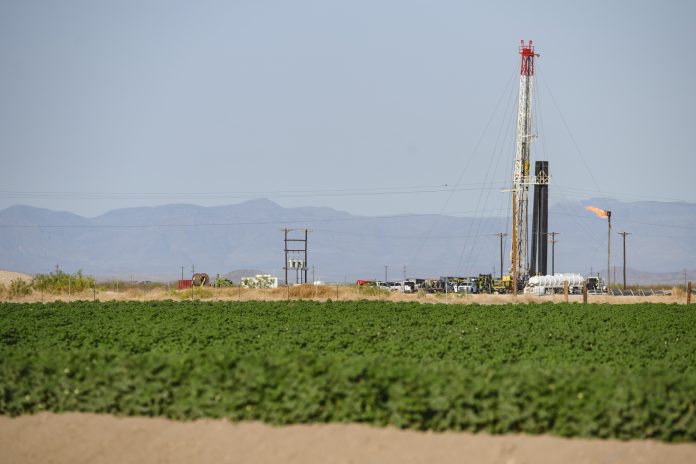
The Permian Basin’s oilfield workforce is meeting the demands of an industry that’s producing an all-time record of six million barrels a day, but there are still plenty of high-paying jobs left for the trained and the untrained who take advantage of the available programs.
That’s according to the Permian Basin Workforce Development Board and the Texas Independent Producers & Royalty Owners and Texas Oil & Gas associations, who say the times are exhilarating but demanding.
Workforce Development Board CEO Willie Taylor said Tuesday that workers are coming into the region from Louisiana, Oklahoma, Pennsylvania, Puerto Rico, El Paso and other places to get in on the action, but 80 percent of the workforce remains homegrown.
“Do we need more workers?” Taylor asked. “Absolutely. We’ll have 5,000 graduating seniors from around this area in May, many of them coming into the workforce, and there are training grants at Odessa College, the University of Texas Permian Basin and Midland College.”
He said many of the workers arriving from other areas immediately move to get commercial drivers’ licenses.
Taylor said another option for oilfield-related training is to apply at Permian Basin Workforce Solutions at 2626 JBS Parkway, Building D.
He said welders, truck drivers and diesel technologists are particularly needed in the oilfield and health care workers, schoolteachers, law enforcement officers and accountants in the general labor force.
“If we had 200 accountants, we could put them all to work today,” Taylor said. “It’s a job seekers’ market.”
TIPRO President Ed Longanecker said from Austin that the demand for talent across all related energy industry sectors in the Permian Basin has increased steadily over the past year in line with growing global demand for oil and natural gas and the record production.
“In fact, this month our data indicates that there was an average of 1,860 unique industry-related job postings throughout the Permian, which was 18 percent higher compared to the same timeframe last year,” Longanecker said. “With many companies competing for the same talent in the region, the median posting duration is often higher for our industry compared to the regional average for these positions. But the jobs are being filled.
“For instance the median posting duration in the Support Activities for Oil and Gas Operations sector in the Permian Basin this month was 37 days compared to the 30-day regional average across all industries.”
Longanecker said some of highest in-demand occupations based on the job postings are maintenance and repair workers, heavy and tractor-trailer truck drivers and roustabouts.
“The top job posted titles include field service technicians, lease operators and field specialists,” he said, adding that the top three counties by industry postings are Midland and Ector counties and Eddy County in New Mexico, where Carlsbad is the county seat.
“Our essential workforce is fueled by many different sources including individuals switching their career paths in search of higher wages, local and out of state talent and targeted programs available through regional educational institutions,” Longanecker said. “The industry in the Permian Basin also attracts individuals from many different demographics with a diversity score of 58 percent based on our data.
“The demand for talent in the region will continue to be highly impacted by market factors, innovation and efficiencies gained by the industry, but these positions will remain in high demand for many years to come.”
TXOGA President Todd Staples said from Austin that the state’s energy industry in 2023 “paid a staggering $26.3 billion in state and local taxes and royalties as well as breaking numerous production records.
“This translates to an extraordinary $72 million every day that helps fund Texas’ public schools, universities, roads, first responders and other essential services,” Staples said. “However, none of this would be possible without a strong workforce to staff the many roles that are needed across the upstream, midstream and downstream sectors of the industry.
“To that end, TXOGA members have for years worked hand in hand with higher education to ensure that the workforce of tomorrow is being developed today. For example, ExxonMobil has partnered with Odessa College to offer industry-focused degree programs and Chevron has worked with Midland College to host site tours to field assets for students.”
Staples said recent data from the Texas Workforce Commission indicates that the upstream exploration and production sector added over 54,700 jobs between September 2020 and December 2023.
“Jobs from oil and gas extraction and support activities comprise this growth including jobs such as welders and truckers and indicating that the demand for these positions is strong and expected to grow in the future,” he said. “To facilitate the connection of workers seeking employment and companies needing to fill jobs, the TXOGA Career Center website is designed to help meet the ever-changing needs of the robust oil and natural gas industry.
“As production continues to increase in the Permian Basin, industry remains committed to investing in and continually strengthening workforce development efforts with local partners to ensure that these irreplaceable resources can be produced for years to come.”



